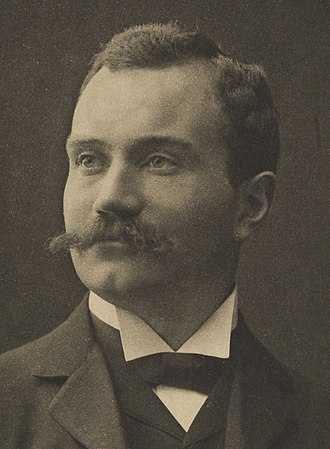Johan Gunnar Andersson

Johan Gunnar Andersson (3 July 1874 – 29 October 1960)[1] was a Swedish archaeologist, paleontologist and geologist, closely associated with the beginnings of Chinese archaeology in the 1920s.
After studies at Uppsala University, and research in the polar regions, Andersson served as Director of Sweden’s National Geological Survey.
He participated in the Swedish Antarctic Expedition of 1901 to 1903 (on the ship Antarctic).
His work on the Falkland Islands and the Bjørnøya, where he first coined the term solifluction, influenced Walery Łoziński create the concept of periglaciation in 1909.[2]
In 1914 he was invited to China as mining adviser to the Chinese government. His affiliation was with China’s National Geological Survey (Dizhi diaochasuo) which was organized and led by the Chinese scholar Ding Wenjiang (V.K. Ting) and his colleague Wong Wen-hao (Pinyin: Weng Wenhao). During this time, Andersson helped train China’s first generation of geologists, and also made numerous discoveries of iron ore and other mining resources, as well as discoveries in geology and paleontology.
Mr. Andersson in China, 1920
Andersson paid his first visit to Zhoukoudian in 1918 drawn to an area called “Chicken Bone Hill” by locals who had misidentified the rodent fossils found in abundance there.[3] He returned in 1921 and was led by local quarrymen to Dragon Bone Hill where he identified quartz that was not local to the area. Realising that this may indicate the presence of prehistoric man he set his assistant, Otto Zdansky, to work excavating. Zdansky returned for further excavations in 1923 and a great deal of material was shipped to Uppsala for analysis. Eventually in 1926, on the occasion of a visit by the Swedish Prince to Beijing, Andersson announced the discovery of two human teeth. These were later identified as being the first finds of the Peking Man.[4]
In collaboration with Chinese colleagues such as Yuan Fuli and others, he then discovered prehistoric Neolithic remains in central China’s Henan Province, along the Yellow River. The remains were named Yangshao culture after the village where they were first excavated, in 1921. This too was a highly important breakthrough, since the prehistory of what is now China had not yet been investigated in scientific archaeological excavations and the Yangshao and other prehistoric cultures were completely unknown (they had never been mentioned in any historical documents, and had never before been recognized and investigated).
In the following years, 1923–24, Andersson, in his capacity as a staff member of China’s National Geological Survey, conducted archaeological excavations in the provinces of Gansu and Qinghai, again in collaboration with Chinese colleagues, and published numerous books and scientific papers on Chinese archaeology, many in the Bulletin of the Museum of Far Eastern Antiquities, which he founded and launched in 1929, and where he published his most significant scientific reports on his own work.
Andersson’s most well-known book about his time in China is Den gula jordens barn, 1932, translated into several languages, including English (as Children of the Yellow Earth, 1934, reprinted 1973), Japanese, and Korean. For an extensive bibliography of Andersson’s works, and a comprehensive discussion of his and his colleagues’ archaeological research in China, see M. Fiskesjö and Chen Xingcan, China before China: Johan Gunnar Andersson, Ding Wenjiang, and the Discovery of China’s Prehistory. Stockholm: Museum of Far Eastern Antiquities [Östasiatiska museet], 2004.
In 1926, Andersson founded the Museum of Far Eastern Antiquities in Stockholm, Sweden (in Swedish: Östasiatiska museet), a national museum established to house the Swedish part of the collections from these first-ever scientific archaeological excavations in China. Andersson served as the director of the MFEA until he was succeeded in 1939 by the famous Swedish Sinologist Bernhard Karlgren.
